essays
Beat Poet Elise Cowen’s Time-Traveling Love Letters to Emily Dickinson

The cult figure’s poems reveal a queer kinship with the canonical poet

Elise Cowen. That’s her name. Archives teach us the importance of naming, assigning an umbrella under which objects are saved and preserved. What you need to know about Elise Cowen is that she’s not quite inside any umbrella. She’s wet.
Born in 1933 in Washington Heights, New York, Cowen was briefly lovers with Allen Ginsberg, and her own poetry is often overshadowed by her associations with Ginsberg both sexually and creatively — she is most well known as the typist of his poem “Kaddish.” Cowen’s work is usually classified as cult rather than canonical, and her name is easily traceable through niche internet articles such as “The Best Female Poet You’ve Never Heard Of” or “The Lady is a Humble Thing” from Beatdom, a website “dedicated to the study of the Beat Generation.”
Cowen’s name is easily traceable through niche internet articles such as “The Best Female Poet You’ve Never Heard Of.”
My journey with Cowen begins in an archive where she is misnamed from the very beginning. I began my hunt with Peter Orlovsky, Ginsberg’s longtime partner and former roommate of Cowen. Searching Orlovsky’s correspondences in the Harry Ransom Center’s Ginsberg Collection, I misspelled Cowen’s name in the search engine, which yielded a single result:

What are the odds that there was also an Elsie Cowan corresponding with Peter Orlovsky? Orlovsky’s life was interesting, but not interesting enough to have an Elsie Cowan and Elise Cowen within the same sphere.
I found the letter and saw that it was typed on Columbia University stationary, another clear indicator that yes, this is Elise. And her signature: a subtle dot in between the i and s, which in cursive could translate to “Elsie” to an archivist, particularly one who didn’t even known Elise existed.
More tantalizing still was an article in the Ginsberg archive entitled “Elise Cowen: A Brief Memoir of the Fifties” written by Leo Skir in August 1967, five years after her death. Skir, at least, was saying her name and spelling it correctly. His writing, however, leaves much of Elise’s life out of the picture. Instead, Skir focuses on the moment in which she entered and exited his life, rather than offering a full or complex portrait of hers.
Support Electric Lit: Become a Member!
What I kept coming back to was Cowen’s signature from the mislabeled letter; that E stands so prominent as to allow the rest of her name to collapse. It reminded me of a similar E from the Dickinson Radical Scatters archive — a collection that includes facsimiles, transcriptions, and full text of fragments from Dickinson’s manuscripts.
I explored manuscript page A254/255, which in “reading view” looks like this:
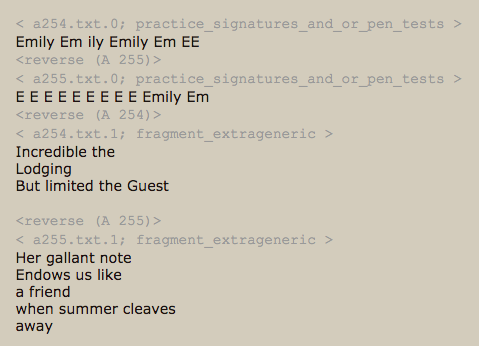
The text itself is haunting, in the way it invokes the writer’s name on the page. Even stranger is the original facsimile. The “E E E E E E E E E” is not spread out evenly as the lineation suggests. Rather, the Es are scattered all over the page, like a child practicing writing her name. I wondered whether this was an original scrap of nothing, a poem that would’ve been discarded if not for the strange process of preserving Dickinson’s work.
I wondered whether this was an original scrap of nothing, a poem that would’ve been discarded if not for the strange process of preserving Dickinson’s work.
A similar process occurred with Elise Cowen’s work, the name of her first collection saying it all: Elise Cowen: Poems & Fragments. This fragmented nature of posthumous work creates its own style over time, regardless of Dickinson’s or Cowen’s original intent to create this brand of aesthetic for their work. While these ethical questions abound, I prefer to view these fragments as watermarks of a writing process. What can we come to understand about Cowen’s and Dickinson’s practices through these ruins?
Our knowledge of Cowen’s writing life is truncated by the destruction of much of her archive. Upon her death in 1962, her parents — upset by the homosexual and drug-related content of Cowen’s work — had a neighbor burn her remaining notebooks and writing. The only surviving notebook consists of 91 poems and fragments, all of which are included in the 2014 collection edited by Tony Trigilio. What the collection lacks in length, it offers in riches of form, content, and play.
The few scholars that have worked on Cowen regard her as an Athena within a Beat Parthenon, Ginsberg at her side. This reading, while not wholly inaccurate, limits Cowen’s work as it only alludes to her contemporary living influences. In Elise Cowen: Poems & Fragments Dickinson is very much present. The collections epigraph reads:
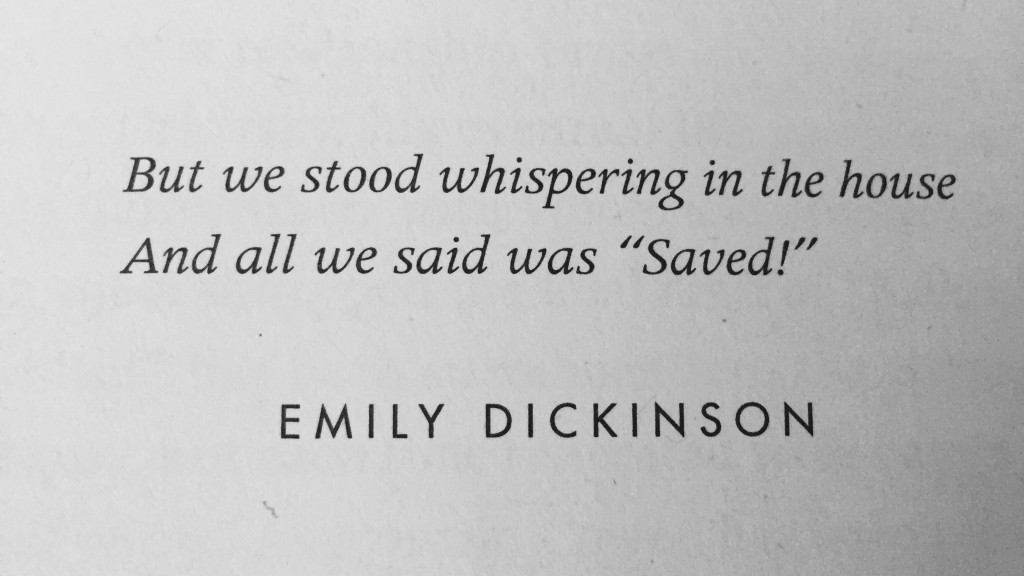
This quote comes from Cowen’s remaining notebook, a passage from Dickinson’s “Of Tribulation, these are They.” Trigilio notes, “It is the only place in the notebook where [Cowen] quotes Dickinson.”
Throughout the collection, Cowen summons Dickinson into her poems not once but twice. First in “[Emily]” and in a later poem “Emily White Witch of Amherst.” Dickinson’s name appears more than that of any other poet in this collection. Not only is she named, but she is the addressee of these two poems.

It isn’t a stretch to imagine that Cowen was, in her mind, conversing with Dickinson. In her review of Elise Cowen: Poems & Fragments, scholar Becca Klaver connects Cowen and Dickinson as contemporaries, noting that Thomas H. Johnson’s variorum edition of Dickinson premiered in 1955, making Dickinson, “not only [Cowen’s] predecessor but also her peer.” This “belated peer” status evolves into a queer kinship as Cowen writes to Dickinson.
The first poem “[Emily]” stands in conversation with the “E E E E E E E E E” fragment from A254/255. This fragment would have been available to Cowen in the 1955 edition of Dickinson. Here, Cowen embodies the simile “like a friend / when summer cleaves / away.” In Dickinson’s poem, the lineation suggest an elongated breath, one that emphasizes the last word in each line, reaching toward “friend” and “cleaves.” There is a note of desire in this pacing, reflecting similar moments from other Dickinson poems such as “Going — To — Her!” In Cowen’s response, she echoes this breath, addressing Dickinson by name:
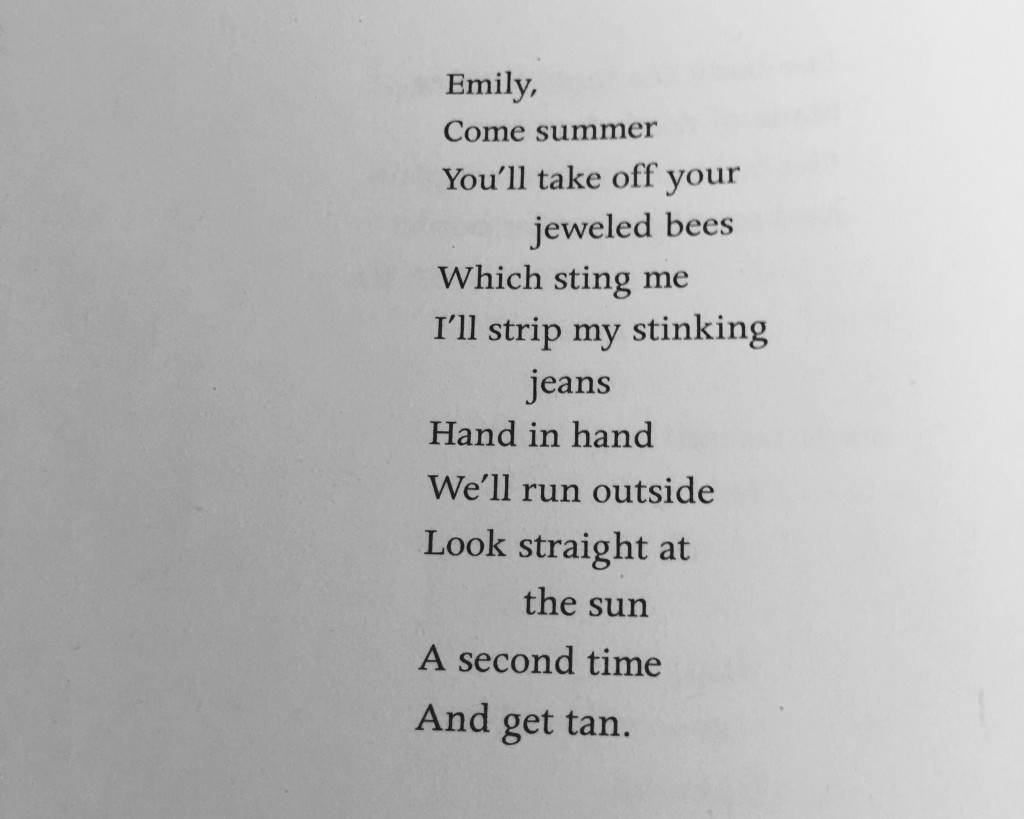
This poem reaches to Dickinson both rhetorically and physically, “hand in hand.” Cowen’s language is saturated with sexual desire, beckoning “Emily, / come.” Cowen alludes to Dickinson’s bees as “jeweled,” which is to say glistening. This gives credence to Cowen’s careful reading of Dickinson’s bees and flowers, which pollinate one another and in so doing work as metaphors for clitorises. In her chapter on Dickinson from Sister Arts: The Erotics of Lesbian Landscapes, Lisa L. Moore cites Paula Bennett’s reading of Dickinson’s “small, round, and frequently hard objects,” such as bees, as clitoral images. Cowen writes “[Emily]” in 1959, years before scholars openly read Dickinson as queer. The bees in this poem sting Cowen, a sexualized but also suicidal act for the bee. At this point in the poem, the bees are off of “Emily,” she herself is naked of the bees and her sexuality is free from the mask of innuendo.
The bees in this poem sting Cowen, a sexualized but also suicidal act for the bee.
Cowen then obliges in taking off her own “stinking jeans.” She often characterizes herself as the girl in jeans throughout this collection. In a later poem, “[I took the skins of corpses],” these jeans are made of corpse skin, another type of communion with the dead and also providing reason for their stench. Upon taking off the “jeweled bees” and “stinking jeans,” Cowen and “Emily” are now together and touch in an escape “outside” of the world. The poem already positions us in a state of imagined desire and fantasy. It continues in this trajectory obfuscating and destabilizing reality.
The Queer Erotics of Handholding in Literature
The two women “look straight,” a jab at heteronormativity. But this is not their first encounter with looking “straight / at the sun,” as the next line notes, “a second time.” This is a second awakening as they move to “get tan,” a return to a natural union of the self and selves.
A queer kinship further emerges in “[Enough of this flabby cock]” with the lines “Enough of this flabby cock / in my head,” a strange parallel to “I felt a funeral, in my Brain.” The caesura created by Cowen’s line break syncs perfectly with Dickinson’s punctuation. Many of Cowen’s poems welcome a type of death, be it transformative or spiritual. Her equating “a funeral” to a “flabby cock” heightens our understanding of Cowen’s humor and distaste for a passive life of sexual complacency.
Her equating “a funeral” to a “flabby cock” heightens our understanding of Cowen’s humor and distaste for a passive life of sexual complacency.
Cowen’s play with the sexual, the experimental, and the canonical reflect an evolution of Dickinson’s “Tell all the truth but tell it slant.” In pursuing her own slanted truth, Cowen crafts a landscape of deep reality and deeper imagination. This presents another type of queering, different from sexual desire, one in which Cowen gives us all of her truth but from a slanted angle of the mind. Here “slant” operates as a guidepost through which to understand Dickinson’s and Cowen’s poetics as undeniably queer. Their work exists out of a necessary desire to be, especially if that means as queer female poets their work must create a new aesthetic, a new poetry altogether.
The quatrain structure of Dickinson’s “I felt a Funeral, in my Brain” echoes in Cowen’s poem “[Enough of this flabby cock],” but less so than her other works which borrow a meter directly from Dickinson. The line “a green automobile” from Cowen’s “[I had a dream of mercy]” alludes to Ginsberg’s own “The Green Automobile,” but the foundation of the poem is its meter, a meter with direct lineage from Dickinson’s ballads:
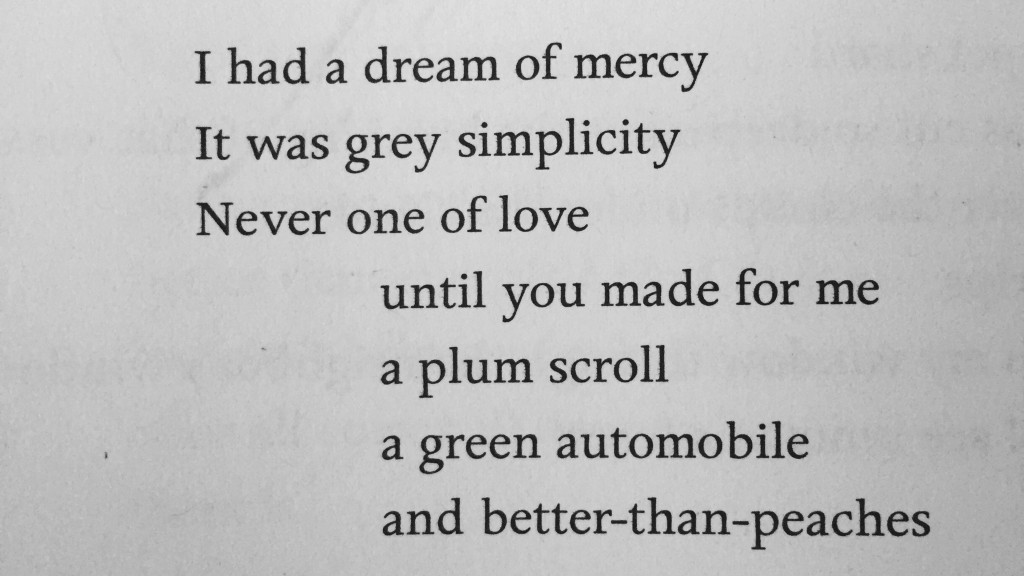
The sturdiness of the ballad meter wanes toward the end, circumventing the expectations of rhyme, but it echoes as watermarks often do, given that this poem’s status as draft, fragment, or complete is unknown.
Conversely, “[I took the skins of corpses]” possesses strict quatrains and meter, which match Dickinson’s ballads such as “My Life had stood — a Loaded Gun.” These poems also pair in their proximity to danger. In Dickinson’s version, this proximity is highlighted with an inability to act, “For I have but the power to kill, / Without — the power to die -.” Whereas with Cowen, the poem dons corpses from the opening line until the final stanza in which the wearer of the dead, barters their own body, “I’ll sell my deadly body.” The use of “deadly” swings between being and being dangerous, having “the power to kill.” Instead of her soul, Cowen sells her body to “the student doctor’s knife,” in essence, sterilizing the spiritual paradigm of good and evil through modern medicine. Cowen is selling “body” as object, body as its own corpse’s skin is wearing another corpse’s skin. The skin is recycled and worn then recycled back into a scientific medical system. In this exchange, death holds power, a power that contrasts sharply yet builds upon the same desire from Dickinson’s “My Life has stood — a Loaded Gun.”
This shared desire operates similarly to the shared E’s of Emily and Elise; it is an act of reaching. Cowen reaches back through form, content, and calls Dickinson by name. Dickinson reaches forward, as all poets do, connecting with an unknown source, channeling her own name on the page before writing.
Cowen reaches back through form, content, and calls Dickinson by name. Dickinson reaches forward, as all poets do, connecting with an unknown source, channeling her own name on the page before writing.
In Cowen’s collection, the poem “Emily White Witch of Amherst” comes right after “[Someone I could kiss]” as though one poem answers the question of another. In “Emily White Witch of Amherst,” Cowen compares herself with Dickinson again. This time, “The shy white witch of Amherst / killed her teachers / with her love” while Cowen reflects “Rather mine entomb / my mind.” With each the teachers are dead, either annihilated or existing only in the mind. In this broad stroke, Cowen summarizes the work of poetry: to move forward and away, forging and digging new ground. Her work surely moves across planes of thought, awareness, and existence. In this movement, it can become difficult to locate Cowen, her titles ranging from “Teacher — Your Body My Kabbalah” to “[I want a cunt of golden pleasure].” But this is how we find her, we dig.
For queer poets, scholars, and those of us who study them, this is as much our work as that of Cowen and Dickinson. The premiere of Elise Cowen: Poems & Fragments in 2014, positions Cowen as our queer peer. Her work as much as it reaches back, reaches forward to us. Understanding that time within poetry is a relative slant, Cowen offers us the poem “I Can’t Remember”:
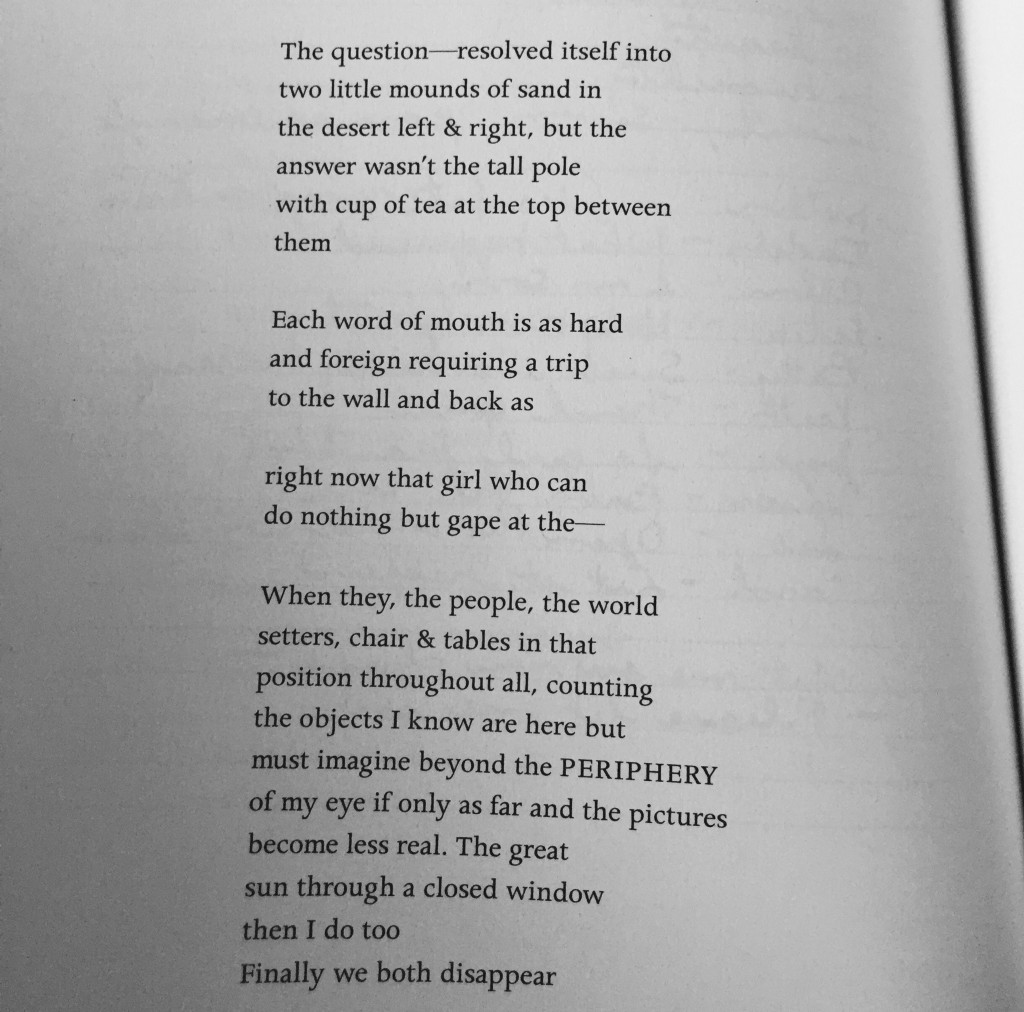
In tracing the genealogical connection between Dickinson, Cowen, and the queer poetics of today, this final line rings. It is not within separate archival umbrellas that we commune. We breathe through the disappearance of these structures, through fragment or desire or slant. This is why we come to poetry, not for answers because as Cowen tells us, “I Can’t Remember / The question.” In killing her teachers, and naming her lovers, Cowen arrives at a point of departure and glides on with her imagined Emily, using poetry as a point of communion across time.










